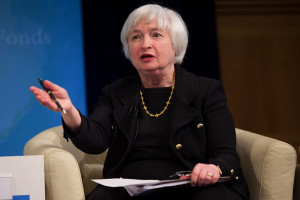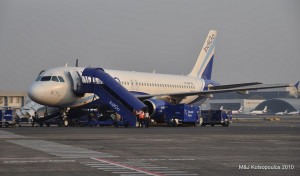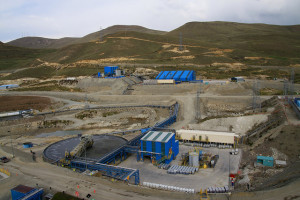By Peter Ward August 21, 2015
September Rate Hike in Doubt

Federal Reserve Chairman Janet Yellen. © International Monetary Fund
On Wednesday this week, the Fed kept interest rates near zero and backed off earlier statements suggesting a rate hike could come as soon as mid September. The Federal Funds Rate, which dictates how much it costs for banks to borrow money from the government and from each other, has been at its current target range of 0 to 0.25 percent since December of 2008. The Fed lowered the rate to recharge the economy following the financial crisis.
As the U.S. economy gets back on its feet, the Fed has been making statements about the possibility that rate hikes could come this year. But consumer prices are not increasing at the rate the Fed would like, according to the New York Times. Over the past 12 months through July, prices jumped just 0.2%, according to a government report also published on Wednesday. That is well below the 2% that the Federal Reserve considers healthy.
The notes from the most recent meeting show that “almost all members” of the Federal Open Market Committee, which determines the direction of monetary policy, “indicated that they would need to see more evidence that economic growth was sufficiently strong” before raising rates. Analysts said they believe the cautious language means interest rates will not be raised at the next opportunity, in mid-September.
Oil Prices Slump

Oil train, © Russ Allison Loar
Oil prices slumped this week, prompting fears they could fall into the $30 range last seen during the height of the financial crisis in 2009.
U.S. oil futures are currently hovering around the $40 mark, as an unexpected increase in inventories this week added to unfavorable sentiment in the market. Analysts are expecting prices to fall further as refineries around the world go into their regular maintenance period in the fall. A drop in production at refineries usually lowers the demand for oil.
On Wednesday the U.S. Energy Information Administration reported that U.S. oil stockpiles had increased over the last week, going against analyst predictions. During Wednesday’s trading session on the New York Mercantile Exchange, West Texas Intermediate crude oil, used as a benchmark for oil pricing, lost 4.3%, reaching its lowest level since March 2009.
The strong value of the dollar and the impending lifting of sanctions on Iran are also affecting oil prices. A stronger dollar makes crude oil more expensive for buyers using other currencies, while Iran is said to be holding around 50 million barrels of oil on tankers, ready to flood the already oversupplied market when international sanctions on the country are lifted.
Walmart Earnings Disappoint
 Walmart, the world’s largest retailer, posted a disappointing quarterly earnings report on Tuesday, and lowered its annual forecast. The company’s net profit fell to $1.08 per share from $1.21 a year earlier, missing Wall Street estimates of $1.12 per share, according to Thomson Reuters.
Walmart, the world’s largest retailer, posted a disappointing quarterly earnings report on Tuesday, and lowered its annual forecast. The company’s net profit fell to $1.08 per share from $1.21 a year earlier, missing Wall Street estimates of $1.12 per share, according to Thomson Reuters.
Walmart lowered its forecast for 2015 to a range of $4.40 to $4.70 earnings per share, down from a February forecast of $4.70 to $5.05.
The retail giant said profits were hit by the decision to increase the hours of store greeters and stocking positions, as part of a larger move to improve customer service. In February, Walmart warned it would be spending an extra $1 billion on higher pay and training, and also announced it would invest in its e-commerce infrastructure.
Traditional high street retailers such as Walmart have come under increasing pressure from the likes of Amazon, which dominates online sales. Amazon recently surpassed Walmart in market value. The Seattle-based e-commerce company is currently worth around $249 billion, while Walmart’s value stands at around $220 billion.
Shares in Walmart fell around 3% on Tuesday, in reaction to the earnings report.
Airbus Inks Record $26.6bn Deal

IndiGo airlines earlier Airbus A320 model at an airport in Mumbai, India ©John and Melanie Illingworth
European aerospace company Airbus finalized a record $26.6 billion deal to sell 250 planes to Indian airline IndiGo on Monday.
The agreement is the single largest order in the company’s history and sees Airbus pull ahead of long-time rival, U.S. manufacturer Boeing, in the narrow-body aircraft market. Indigo will receive 250 A320neo aircraft, which are currently outselling Boeing’s equivalent, the 737 Max.
Airbus has received over 4,000 orders for the A320neo, a single aisle plane, while Boeing has secured fewer than 3,000 orders for the 737 Max, The Guardian reports.
IndiGo is India’s largest airline, and holds a 38% share of the local market, according to Bloomberg. The company previously ordered 180 A320neo planes, as well as 100 of the previous model, the A320. India’s air travel market is set to become the third largest in the world by 2031, according to research from the International Air Transport Association.
John Leahy, Airbus chief operating officer, said: “It fills us with pride that IndiGo, India’s largest airline and one of the early launch customers for the A320neo, is coming back for more of our benchmark aircraft. This order confirms the A320 family as the airliner of choice in the most dynamic aviation growth markets.”
Glencore’s Fall From Grace

Glencore Antapaccay copper mine in Peru © Golda Fuentes
When Swiss mining and commodities giant Glencore (Now Glencore Xstrata) went public in 2011, six of its executives became billionaires. A year ago, the company had completed a $29.5 billion acquisition of rival Xstrata, and was planning a $150 billion move for another competitor, Rio Tinto. It was on the rise. But over the past 12 months, the company’s stock price has lost more than half its value.
Glencore Xstrata’s dramatic fall from grace, brought on by falling prices for coal, copper and other commodities, has been well documented this week after the firm posted a brutal loss for the first half of the year, sending shares tumbling 10% on Wednesday.
Both The Wall Street Journal and Bloomberg used data visualizations to highlight the decline.
Bloomberg focused on the 70% fall in share price since the company’s IPO in 2011, and also produced graphics on the dwindling fortunes of Glencore executives. (Only three of its executives remain billionaires.) The latter shows the value of the executive’s stake in the company at the time of going public and now.
The Wall Street Journal’s graphics examined the company’s operating profit, and noted the $0.4 billion decline between the first half of this year and the same period in 2014. Another data graphic showed Glencore’s decline on the stock market compared to its competitors.
This entry was posted on Friday, August 21st, 2015 at 3:59 pm. It is filed under Week in Review and tagged with Airbus, Glencore Xstrata, IndiGo, interest rate hike, oil prices, walmart. You can follow any responses to this entry through the RSS 2.0 feed.
Comments are closed.
